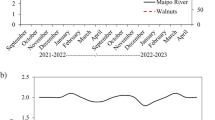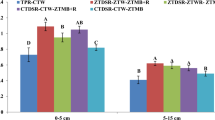Abstract
The presence of excessive salts in the soil and irrigation water can change the growth and affect the metabolic functions of plants. Coriander (Coriandrum sativum L.) is often cultivated in arid and semiarid areas where irrigation with low-quality water and uneven distribution of rainfall may contribute to the accumulation of salts in the substrate. In the present study, coriander plants were cultivated in half-strength Hoagland nutrient solution containing 0.2, 0.6 and 1.2 g NaCl L−1 to assess the effect of low concentrations of NaCl on biomass production and mineral nutrients accumulation (Ca, K, Mg, Na, P). The presence of 0.2, 0.6 and 1.2 g NaCl L−1 slightly stimulated biomass production. The concentration of Na increased in coriander tissues (up to 4 times relative to control). However, concentration of K and Ca in leaves of plants treated with 1.2 g NaCl L−1 was decreased with respect to control. Based on the findings, even though biomass of coriander, under applied NaCl concentrations, was slightly increased, the chemical composition of its vegetative organs was severely disrupted by present salt which is very important for the quality of coriander as a popular herb or spice plant.

Similar content being viewed by others
References
Aghaei K, Kamatsu S (2013) Crop and medicinal plants proteomics in response to salt stress. Front Plant Sci 4:8
Ahmadi M, Souri MK (2018) Growth and mineral content of coriander (Coriandrum sativum L.) plants under mild salinity with different salts. Acta Physiol Plant 40:194
Alam SM (1999) Nutrient uptake by plants under stress conditions. In: Pessarakli M (ed) Handbook of plant and crop stress. Marcel Dekker Press Inc., New York, pp 285–314
Awad AS, Edwards DG, Campbell LC (1990) Phosphorus enhancement of salt tolerance of tomato. Crop Sci 30:122–128
Brady CJ, Gibson TS, Barlow EWR, Spiers J, Wyn Jonen RG (1984) Salt tolerance in plants. I. Ions, compatible solutes and the stability of plant ribosomes. Plant Cell Environ 7:571–578
Chen H, Diao J, Li Y, Chen Q, Kong B (2016) The effectiveness of clove extracts in the inhibition of hydroxyl radical oxidation-induced structural and rheological changes in porcine myofibrillar protein. Meat Sci 111:60–66
Clarkson DT (1984) Calcium transport between tissues and its distribution in the plant. Plant Cell Environ 7:449–456
Cramer GR, Laüchli A, Polito VS (1985) Displacement of Ca++ by Na+ from the Plasmalemma of root cell. A primary response to salt stress? Plant Physiol 75:207–211
Elouaer MA, Hannachi C (2013) Influence of seed priming on emergence and growth of coriander (Coriandrum sativum L.) seedlings grown under salt stress. Acta Agric Slov 10:41–47
FAO, Food and Agriculture Organization of the United Nations 2015. Status of the World’s soil resources. p 650
Füzy A, Kovács S, Cseresnyés I, Parádi I, Szili-Kovács T, Kelemen B, Rajkai K, Takács T (2019) Selection of plant physiological parameters to detect stress effects in p ot experiments using principal component analysis. Acta Physiol Plant 41:56
Hirpara KD, Ramoliya PJ, Patel AD, Pandey AN (2005) Effect of salinization of soil on growth and macro-and micronutrient accumulation in seedlings of Butea monosperma (Fabaceae). An Biol 27:3–14
Hoagland DR, Arnon DI (1950) The water-culture method for growing plants without soil. Calif Agric Exp Stat Circ 347:1–32
Irving W, Shannon M, Breda V, Mackey B (1988) Salinity effects on yield and oil quality of high-linoleate and high-oleate cultivars of safflower (Carthamus tinctorius L.). J Agric Food Chem 36:37–42
Kostić G (2014) Elektrolitička provodljivost, merenje i etaloniranje merne opreme. [Electric conductance, measurement and calibration of measuring equipment]. Guidance SY285. Symmetry, Leskovac, Serbia
Maksimović I, Putnik-Delić M, Gani I, Marić J, Ilin Ž (2010) Growth, ion composition and stomatal conductance of peas exposed to salinity. Cent Eur J Biol 5:5
Marschner H (2011) Mineral nutrition of higher plants, 3rd edn. Aca-demic Press, London
Meriem BF, Zhani K, Hannachi C, Mehwachi T, Belanger A (2014) Effects of priming on growth, biochemical parameters and mineral composition of different cultivars of coriander (Coriandrum sativum L.) under salt stress. J Stress Physiol and Biochem 10:84–109
Ministry of agriculture, fisheries and food. Agricultural Development and Advisory Service. (MAFF/ADAS) (1986) The analysis of agricultural materials, 3rd edn. HMSO, London
Munns R, Gilliham M (2015) Salinity tolerance of crops – What is the cost? New Phytol 208:668–673
Murillo-Amador B, Cordoba-Matson MV, Villegas Espinosa JA, Hernandez-Montiel LG, Troyo-Dieguez E, García-Hernández JL (2014) Mineral content and biochemical variables of Aloe vera L. under salt stress. PLOS ONE 9:94870
Neffati M, Marzouk B (2008) Changes in essential oil and fatty acid composition in coriander (Coriandrum sativum L.) leaves under saline conditions. Ind Crop Prod 28:137–142
Parida AK, Daas AR, Mittra B (2005) Effects of salt on growth, ion accumulation, photosynthesis and leaf anatomy of the mangrove, Bruquiera parviflora. Trees-Struct Funct 18:167–174
Qui Z, Spalding EP (2004) Protection of plasma membrane K+ transport by the salt overly sensitive Na+-H+ antiporter during salinity stress. Plant Physiol 136:2548–2555
Rahneshan Z, Nasibi F, Moghadam AA (2018) Effects of salinity stress on some growth, physiological, biochemical parameters and nutrients in two pistachio (Pistacia vera L.) rootstocks. J Plant Interact 13:73–82
Ramoliya PJ, Patel HM, Pandey AN (2004) Effect of salinisation of soil on growth and macro- and micro-nutrient accumulation in seedlings of Acacia catechu (Mimosaceae). Ann Appl Biol 144:321–332
Salem N, Msaada K, Dhifi W, Limam F, Marzouk B (2014) Effect of salinity on plant growth and biological activities of Carthamus tinctorius L. extracts at two flowering stages. Acta Physiol Plant 36:433–445
Seghatoleslami M (2011) Effect of salt stress on germination of Satureja hortensis L., Cichorium intybus L. and Cynara scolymus L. J Iranian Field Crop Res 8:818–823
Selmar D, Kleinwachter M (2013) Influencing the product quality by deliberately applying drought stress during the cultivation of medicinal plants. Ind Crop Prod 42:558–566
Shao HB, Chu LY, Jaleel C, Zhao CX (2008) Water-deficit stress-induced anatomical changes in higher plants. Compt Rend Biol 331:215–225
Turan AM, Elkarim AHA, Taban N, Taban S (2010) Effects of salt stress on growth and ion distribution and accumulation in shoot and root of maize plant. Afric J Agric Res 5:584–588
Veena S, Manu S (2014) Validation of therapeutic claims of Allium sativum and Coriandrum sativum with potential pharmacological value. A Review Int Pharmaceut Sci 4:1–13
Zhuo Y, Zhang Y, Xie G, Xiong S (2015) Effects of salt stress on biomass and ash composition of switchgrass (Panicum virgatum). Acta Agric Scandinav Section B- Soil and Plant Sci 65:300–309
Acknowledgements
The authors would like to thank Mr Stevan Arsenijević for linguistic revision, Dr. Ana Marjanović-Jeromela who provided us with seeds of Coriandrum sativum L. and Ministry of Education, Science and Technological Development of Serbia for financial support (451-03-9/2021-14/200117.).
Author information
Authors and Affiliations
Corresponding author
Ethics declarations
Conflict of interest
On behalf of all authors, the corresponding author states that there is no conflict of interest.
Rights and permissions
About this article
Cite this article
Daničić, M., Maksimović, I., Putnik-Delić, M. et al. Biomass production and mineral composition of coriander (Coriandrum sativum L.) exposed to NaCl. BIOLOGIA FUTURA 72, 453–459 (2021). https://doi.org/10.1007/s42977-021-00090-4
Received:
Accepted:
Published:
Issue Date:
DOI: https://doi.org/10.1007/s42977-021-00090-4




